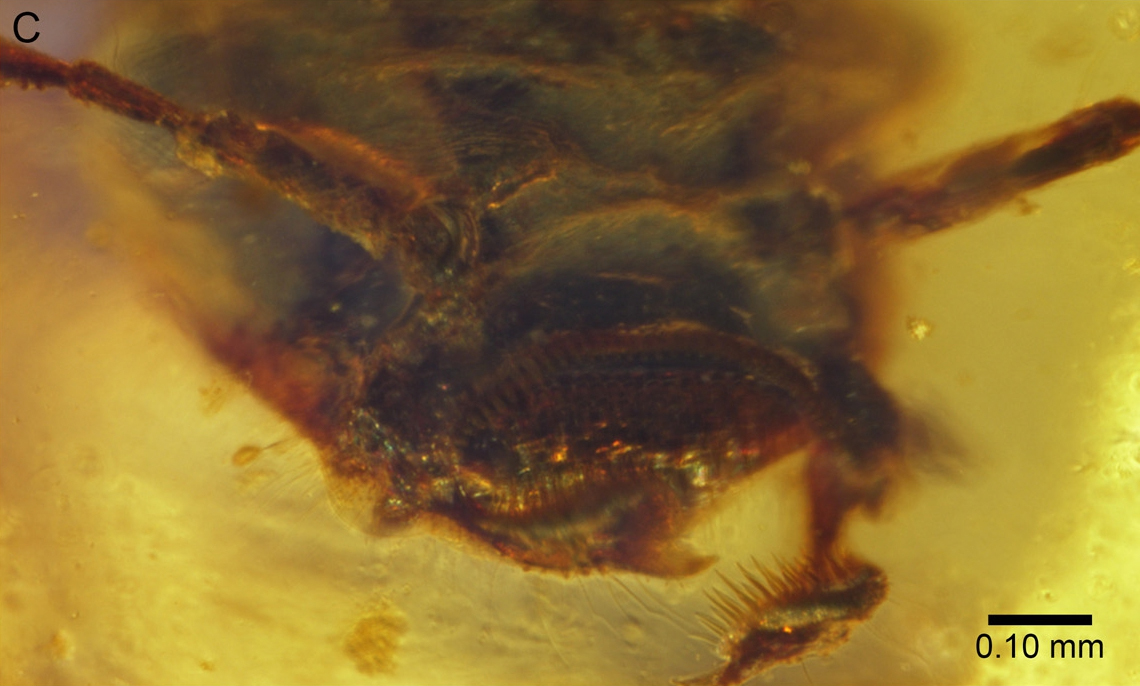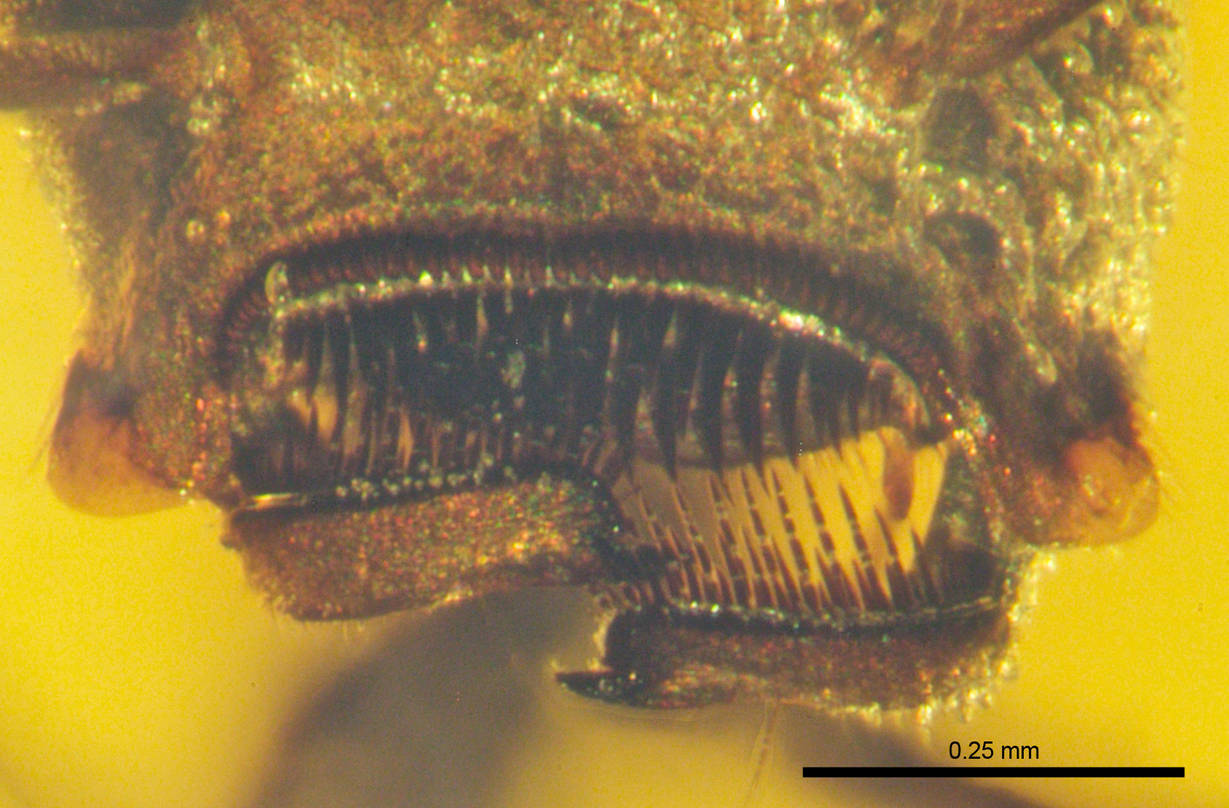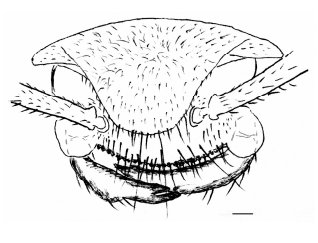|
Zigrasimeciinae
Zigrasimeciinae is a subfamily of ants, known from the Cretaceous period, originally named as the tribe Zigrasimeciini within the subfamily Sphecomyrminae by Borysenko, 2017, it was elevated to full subfamily in 2020. It contains three described genera. They are sometimes known as "iron-maiden ants" in reference to their densely spiked mouthparts, reminiscent of an iron maiden torture device, that were likely used to trap prey. ''Boltonimecia canadensis'' was described from Campanian Canadian amber out of Alberta, Canada, while the species of '' Protozigrasimecia'' and ''Zigrasimecia'' are both exclusively known from Cenomanian Burmese amber found in Myanmar. Genera and species * ''Boltonimecia'' ** ''B. canadensis'' *'' Protozigrasimecia'' ** ''P. chauli'' * ''Zigrasimecia ''Zigrasimecia'' is an extinct genus of ants which existed in the Cretaceous period approximately 98 million years ago. The first specimens were collected from Burmese amber in Kachin State, west ... [...More Info...] [...Related Items...] OR: [Wikipedia] [Google] [Baidu] |
Zigrasimecia Hoelldobleri
''Zigrasimecia'' is an extinct genus of ants which existed in the Cretaceous period approximately 98 million years ago. The first specimens were collected from Burmese amber in Kachin State, west of Myitkyina town in Myanmar. In 2013, palaeoentomologists Phillip Barden and David Grimaldi published a paper describing and naming ''Zigrasimecia tonsora''. They described a dealate female with unusual features, notably the highly specialized mandibles. Other features include large ocelli, short scapes, 12 antennomeres, small eyes, and a clypeal margin that has a row of peg-like denticles. The genus ''Zigrasimecia'' was originally ''incertae sedis'' (uncertain placement) within Formicidae until a second species, ''Zigrasimecia ferox'', was described in 2014, leading to its placement in the subfamily Sphecomyrminae. Later, it was considered to belong to the distinct subfamily Zigrasimeciinae. Due to the highly specialized mandibles, scientists believe that the ants exhibited habit ... [...More Info...] [...Related Items...] OR: [Wikipedia] [Google] [Baidu] |
Zigrasimecia Ferox
''Zigrasimecia'' is an extinct genus of ants which existed in the Cretaceous period approximately 98 million years ago. The first specimens were collected from Burmese amber in Kachin State, west of Myitkyina town in Myanmar. In 2013, palaeoentomologists Phillip Barden and David Grimaldi published a paper describing and naming ''Zigrasimecia tonsora''. They described a dealate female with unusual features, notably the highly specialized mandibles. Other features include large ocelli, short scapes, 12 antennomeres, small eyes, and a clypeal margin that has a row of peg-like denticles. The genus ''Zigrasimecia'' was originally ''incertae sedis'' (uncertain placement) within Formicidae until a second species, ''Zigrasimecia ferox'', was described in 2014, leading to its placement in the subfamily Sphecomyrminae. Later, it was considered to belong to the distinct subfamily Zigrasimeciinae. Due to the highly specialized mandibles, scientists believe that the ants exhibited habit ... [...More Info...] [...Related Items...] OR: [Wikipedia] [Google] [Baidu] |
Zigrasimecia Tonsora
''Zigrasimecia'' is an extinct genus of ants which existed in the Cretaceous period approximately 98 million years ago. The first specimens were collected from Burmese amber in Kachin State, west of Myitkyina town in Myanmar. In 2013, palaeoentomologists Phillip Barden and David Grimaldi published a paper describing and naming ''Zigrasimecia tonsora''. They described a dealate female with unusual features, notably the highly specialized mandibles. Other features include large ocelli, short scapes, 12 antennomeres, small eyes, and a clypeal margin that has a row of peg-like denticles. The genus ''Zigrasimecia'' was originally ''incertae sedis'' (uncertain placement) within Formicidae until a second species, ''Zigrasimecia ferox'', was described in 2014, leading to its placement in the subfamily Sphecomyrminae. Later, it was considered to belong to the distinct subfamily Zigrasimeciinae. Due to the highly specialized mandibles, scientists believe that the ants exhibited habit ... [...More Info...] [...Related Items...] OR: [Wikipedia] [Google] [Baidu] |
Zigrasimecia
''Zigrasimecia'' is an extinct genus of ants which existed in the Cretaceous period approximately 98 million years ago. The first specimens were collected from Burmese amber in Kachin State, west of Myitkyina town in Myanmar. In 2013, palaeoentomologists Phillip Barden and David Grimaldi published a paper describing and naming ''Zigrasimecia tonsora''. They described a dealate female with unusual features, notably the highly specialized mandibles. Other features include large ocelli, short scapes, 12 antennomeres, small eyes, and a clypeal margin that has a row of peg-like denticles. The genus ''Zigrasimecia'' was originally ''incertae sedis'' (uncertain placement) within Formicidae until a second species, ''Zigrasimecia ferox'', was described in 2014, leading to its placement in the subfamily Sphecomyrminae. Later, it was considered to belong to the distinct subfamily Zigrasimeciinae. Due to the highly specialized mandibles, scientists believe that the ants exhibited habit ... [...More Info...] [...Related Items...] OR: [Wikipedia] [Google] [Baidu] |
Ants
Ants are eusocial insects of the family Formicidae and, along with the related wasps and bees, belong to the order Hymenoptera. Ants evolved from vespoid wasp ancestors in the Cretaceous period. More than 13,800 of an estimated total of 22,000 species have been classified. They are easily identified by their geniculate (elbowed) antennae and the distinctive node-like structure that forms their slender waists. Ants form colonies that range in size from a few dozen predatory individuals living in small natural cavities to highly organised colonies that may occupy large territories and consist of millions of individuals. Larger colonies consist of various castes of sterile, wingless females, most of which are workers (ergates), as well as soldiers (dinergates) and other specialised groups. Nearly all ant colonies also have some fertile males called "drones" and one or more fertile females called "queens" (gynes). The colonies are described as superorganisms because the ants appea ... [...More Info...] [...Related Items...] OR: [Wikipedia] [Google] [Baidu] |
Boltonimecia
''Boltonimecia'' is an extinct genus of ant in the formicid subfamily Zigrasimeciinae. The genus contains a single described species, ''Boltonimecia canadensis'', and is known from a single Late Cretaceous fossil which was found in Canada. The type species was originally described as a species of the extinct genus '' Sphecomyrma'' under the combination ''Sphecomyrma canadensis''. History and classification ''Boltonimecia'' is known from a single adult fossil, the holotype, specimen number "CAS 330" entombed in an amber chunk. At the time of the genus description, the specimen was residing in the Canadian National Collection of Insects, Arachnids and Nematodes, in Ottawa, Canada. The described specimen is of a worker caste adult which has been preserved as an inclusion in a transparent orange chunk of Canadian amber. The amber specimen was recovered ''in situ'' from the Taber coal zone near the top of Foremost Formation around Grassy Lake which is near Medicine Hat, Albe ... [...More Info...] [...Related Items...] OR: [Wikipedia] [Google] [Baidu] |
Boltonimecia Canadensis
''Boltonimecia'' is an extinct genus of ant in the formicid subfamily Zigrasimeciinae. The genus contains a single described species, ''Boltonimecia canadensis'', and is known from a single Late Cretaceous fossil which was found in Canada. The type species was originally described as a species of the extinct genus '' Sphecomyrma'' under the combination ''Sphecomyrma canadensis''. History and classification ''Boltonimecia'' is known from a single adult fossil, the holotype, specimen number "CAS 330" entombed in an amber chunk. At the time of the genus description, the specimen was residing in the Canadian National Collection of Insects, Arachnids and Nematodes, in Ottawa, Canada. The described specimen is of a worker caste adult which has been preserved as an inclusion in a transparent orange chunk of Canadian amber. The amber specimen was recovered ''in situ'' from the Taber coal zone near the top of Foremost Formation around Grassy Lake which is near Medicine Hat, Albe ... [...More Info...] [...Related Items...] OR: [Wikipedia] [Google] [Baidu] |
Sphecomyrminae
Sphecomyrminae is an extinct subfamily of ants in family Formicidae known from a series of Cretaceous fossils found in North America, Europe, and Asia. Sphecomyrminae contains eight genera, divided into two tribes Sphecomyrmini and Zigrasimeciini. The tribe Sphecomyrmini contains the six genera '' Armania'', '' Cretomyrma'', ''Gerontoformica'', '' Orapia'', '' Pseudarmania'' and ''Sphecomyrma''; while Zigrasimeciini contains ''Boltonimecia'' and ''Zigrasimecia''. A number of taxa have been removed from the subfamily and placed either in other subfamilies or are now treated as ''incertae sedis'' in Formicidae. Sphecomyrminae is the most basal of the Formicidae subfamilies, but has not been included in several phylogenetic studies of the family. Symplesiomorphies of the subfamily include the structure of the antenna, which has a short basal segment and a flexible group of segments below the antenna tip. The petiole is low and rounded, with an unrestricted gaster and the presence of ... [...More Info...] [...Related Items...] OR: [Wikipedia] [Google] [Baidu] |
Campanian
The Campanian is the fifth of six ages of the Late Cretaceous Epoch on the geologic timescale of the International Commission on Stratigraphy (ICS). In chronostratigraphy, it is the fifth of six stages in the Upper Cretaceous Series. Campanian spans the time from 83.6 (± 0.2) to 72.1 (± 0.2) million years ago. It is preceded by the Santonian and it is followed by the Maastrichtian. The Campanian was an age when a worldwide sea level rise covered many coastal areas. The morphology of some of these areas has been preserved: it is an unconformity beneath a cover of marine sedimentary rocks. Etymology The Campanian was introduced in scientific literature by Henri Coquand in 1857. It is named after the French village of Champagne in the department of Charente-Maritime. The original type locality was a series of outcrop near the village of Aubeterre-sur-Dronne in the same region. Definition The base of the Campanian Stage is defined as a place in the stratigraphic column wher ... [...More Info...] [...Related Items...] OR: [Wikipedia] [Google] [Baidu] |
Canadian Amber
Canadians (french: Canadiens) are people identified with the country of Canada. This connection may be residential, legal, historical or cultural. For most Canadians, many (or all) of these connections exist and are collectively the source of their being ''Canadian''. Canada is a multilingual and multicultural society home to people of groups of many different ethnic, religious, and national origins, with the majority of the population made up of Old World immigrants and their descendants. Following the initial period of French and then the much larger British colonization, different waves (or peaks) of immigration and settlement of non-indigenous peoples took place over the course of nearly two centuries and continue today. Elements of Indigenous, French, British, and more recent immigrant customs, languages, and religions have combined to form the culture of Canada, and thus a Canadian identity. Canada has also been strongly influenced by its linguistic, geographic, and e ... [...More Info...] [...Related Items...] OR: [Wikipedia] [Google] [Baidu] |
Cretaceous
The Cretaceous ( ) is a geological period that lasted from about 145 to 66 million years ago (Mya). It is the third and final period of the Mesozoic Era, as well as the longest. At around 79 million years, it is the longest geological period of the entire Phanerozoic. The name is derived from the Latin ''creta'', "chalk", which is abundant in the latter half of the period. It is usually abbreviated K, for its German translation ''Kreide''. The Cretaceous was a period with a relatively warm climate, resulting in high eustatic sea levels that created numerous shallow inland seas. These oceans and seas were populated with now- extinct marine reptiles, ammonites, and rudists, while dinosaurs continued to dominate on land. The world was ice free, and forests extended to the poles. During this time, new groups of mammals and birds appeared. During the Early Cretaceous, flowering plants appeared and began to rapidly diversify, becoming the dominant group of plants across the Earth b ... [...More Info...] [...Related Items...] OR: [Wikipedia] [Google] [Baidu] |







